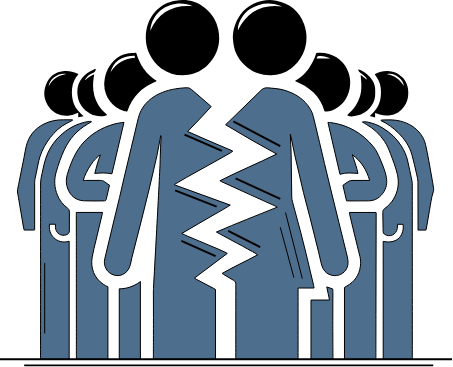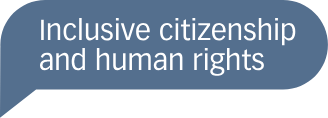Course: Genocide and Group Hostility
Module 2: Prevention
Mass atrocities can be prevented, but how? And who is supposed to do so?

Preventing mass atrocities before they happen is not an easy task. For this reason, the international community has come up with regulations and frameworks to guide prevention efforts. Recognizing warning signals of impending atrocities may help prevent them.
In the aftermath of the Srebrenica genocide, the role of UN peacekeeping forces underwent scrutiny and criticism. Peacekeepers were already stationed in the region, but they were not able to prevent the escalating violence due to their mandate, which limited intervention. (Read more about the case here)
Early-warning indicators
Through risk assessments and warning indicators, atrocity crimes may be predicted and potentially prevented. These measures can consist of structural prevention, direct prevention, and late-stage prevention. Effective prevention requires relevant knowledge, continuous collaboration, and solid frameworks.
While risk assessment and early warning mechanisms are often used interchangeably, there are certain differences:
Risk assessments:
- predictive, based on previous experiences,
- focus on state-level indicators, often using quantitative data,
- examine structures that rarely change abruptly (political (in)stability, prior atrocities, and widespread discrimination),
- overall picture of the risk of atrocities,
- highlight situations where atrocities likely could happen.
Early warnings:
- causal, grounded in current events,
- focus in-depth on high-risk cases,
- monitor situations of insecurity or elevated risk,
- more dynamic, context-specific, and sensitive to rapid developments,
- focus on escalating activity, tipping points, and triggering acts or rhetoric,
- indicate with a higher likelihood whether and when atrocities will happen.
Early warning of upcoming atrocities is often carried out by monitoring a wide set of acts and trends, acting as indicators of the potential beginning or escalation of violence. Here are a few:
Leadership and regime
- Polarisation of elites.
- Upcoming and contested elections.
- Public commemoration of past crimes.
- Rapid change in government leadership (assassination, coup).
- Removing moderates from leadership.
- Attacks (arrests, torture, killings) on political leaders or other prominent figures.
Discrimination and rhetoric
- Increased hate speech, apocalyptic public rhetoric.
- Popular mobilisation against groups; labelling groups as enemies.
- Discriminatory or emergency legislation.
- Increase in repressive practices, removal of political rights.
- Segregation and separation of groups.
Conflict dynamics
- Increase in irregular armed forces and security forces, increase in opposition capacity.
- Increase in stockpiling and transfer of weapons.
- Commencement and resumption of armed conflict, spillover from neighbouring countries.
- Lack of opportunities to flee.
- Impunity for past crimes.
(To learn more about RA and EW mechanisms, read this article from Ellen E. Stensrud)
Gender Perspective & Early Warning Signs
Gender is a factor in the preparation and perpetration of mass atrocities. Paying attention to gender inequalities, hateful rhetoric, and escalating domestic violence can help identify the risk of atrocities.
Mass atrocities often involve gender-specific patterns of violence and victimization. Early-warning indicators that ignore these dimensions may fail to detect key risks.
To address these gaps and ensure more comprehensive prevention measures, the following gender-specific indicators may be incorporated into early warning frameworks, as suggested by Louise Allen in her report “Overview of Gender Responsive Early Warning Systems – Progress and Gaps”:
- Increases in sexist, homophobic or misogynistic hate speech and propaganda.
- The targeting of women by state and non-state actors, both online and physically.
- Changes and growing restrictions on civil society, in particular women’s organisations, dress codes, and mobility.
- Resistance to women’s participation in peacebuilding/conflict prevention or resolution efforts.
- Sudden drop in girls attending school due to security threats/attacks on girls schools.
- Changes in sex work/survival sex (forced or voluntary).
- Changes to access in emergency health services.
The full report on gender-sensitive indicators by Louise Allen is available here.
Gender-sensitive Approach to Prevention
Many atrocity prevention approaches give limited attention to how gender dynamics can influence patterns of violence. Incorporating gender-sensitive perspectives into prevention efforts may help identify concerns that might otherwise remain overlooked.
Responses to Mass Atrocities
Mass atrocities can potentially be predicted and prevented, but guidelines and political will are necessary to make sure this can be achieved. Multiple conventions, documents, and institutions exist to prevent and punish atrocity crimes, such as the Responsibility to Protect (R2P) doctrine. The mere declaration of intent is not enough, however.
Article I: The Contracting Parties confirm that genocide, whether committed in time of peace or in time of war, is a crime under international law which they undertake to prevent and to punish.
The Responsibility to Protect (R2P) is a global political commitment to prevent the worst forms of violence and human rights abuses, guiding reasons and procedures for atrocity prevention.
Affirmed unanimously at the UN 2005 World Summit, R2P emerged as a response to the international community’s failure to halt the atrocities committed in the Balkans and Rwanda during the 1990s. It builds on states’ pre-existing international humanitarian and human rights obligations to prevent and punish genocide, war crimes, ethnic cleansing, and crimes against humanity.
Although not legally binding, the R2P doctrine guides the scope of states’ political commitments to protect civilian populations. At the same time, the effectiveness of R2P depends on the political will of states and the international community to implement its principles in practice.
Since 2009, the UN Secretary General (UNSG) has issued yearly reports on R2P. The first report laid out a three-pillar strategy for the implementation of this norm.
These three pillars, which guide prevention approaches, make sure that each approach is weighed against the specific circumstances of each case. This way, the primary responsibility rests upon each state to protect their own populations, explicitly placing R2P within the boundaries of the UN security framework.
- Pillar One: Each state has the primary responsibility to protect its population from atrocity crimes.
- Pillar Two: The international community must assist and encourage individual states to fulfil their responsibility to protect, when they are unwilling or unable to do so.
- Pillar Three: In case a state fails to meet its obligations, the international community may respond in a ‘timely and decisive’ manner by using the range of peaceful and non-peaceful means available under Chapters VI, VII and VIII of the UN Charter.
ICJ rulings on the duty to prevent
The ICJ is the principal international legal authority and is one of the few international courts that can legally recognize genocides. At the same time, the ICJ can intervene to promote State accountability, imposing sanctions and rulings that affect all states.
Disputes between states concerning the interpretation, application, or fulfilment of the Convention, including obligations to prevent and punish genocide, may be referred to the International Court of Justice (ICJ). This provision gives the ICJ the primary responsibility for resolving inter-state disputes under the Convention. However, the ICJ does not have jurisdiction to conduct individual criminal trials for genocide, a function generally carried out by the ICC or ad-hoc international criminal tribunals (see Module 3 – Restorative Justice).
Recent genocide cases:
The International Court of Justice has advanced provisional measures on its application of the Genocide Convention both in Myanmar and the Gaza Strip. Myanmar and Israel have been instructed to ensure the protection and prevention of civilian populations (Rohingyas and Palestinians, respectively), as well as the cessation of violence.
Here are the ICJ reports:
The International Court of Justice (ICJ), established in 1945, is the principal judicial body of the United Nations. It handles contentious cases between states that voluntarily submit disputes for resolution, as well as provides advisory opinions on legal questions referred by UN organs and specialized agencies. The ICJ plays a crucial role in codifying and interpreting international law, setting legal precedents that influence the practices of states. It does not have automatic jurisdiction; it only hears cases where the parties have agreed to its jurisdiction, either through treaties or special agreements.
Role of different stakeholders
Individual states, humanitarian and legal entities, and the international community at large each have different roles in preventing atrocity crimes. It is often difficult to reach a consensus on when to intervene and what constitutes legitimate intervention at all.
The question of who is supposed to prevent atrocities, and when intervention is deemed necessary, has been addressed by the R2P doctrine through a hierarchy of intervention. As outlined in the doctrine, in order of priority, prevention and intervention should be attempted by:
- Country where atrocities are about to happen/are happening
- Neighbouring states in the region
- International community at large
This hierarchy highlights the circumstances under which members of the international community may take preventive action, thereby limiting interventions that could threaten state sovereignty. Ideally, the international community should help states become self-sufficient in preventing mass atrocities.
Education as prevention strategy
Learning from the past can ideally be a basis for the prevention of future atrocities. Yet education alone cannot prevent genocide. Education can, along with other social factors, reinforce the belief in individual and group identity as a unifying rather than dividing factor.
Awareness and education strategies that engage women, civil society, and religious institutions may play an important part in creating attitudes that may help building resistance and awareness that may contribute to preventing mass atrocities. Additionally, through education it could be possible to create awareness about the indicators of escalation leading to genocide, so that civil society may also actively engage in early-warning and risk assessment. (See Module 4 – Group Hostility)
Questions for reflection and discussion
- How can different stakeholders work together to implement genocide prevention measures?
- In what ways can the inclusion of a gender perspective strengthen early warning systems for mass atrocity prevention?
- What potential barriers and dilemmas may arise in early intervention?
- How does media coverage influence international response? What role does geopolitical interest play in determining which atrocities receive attention and intervention?
- Case study discussion:
- How can the escalation of violence before the Srebrenica genocide help us recognize warning signs and develop better prevention strategies?
- What lessons can be learned from this case about intervention and the responsibility to protect from mass atrocities?
For Educators
- Learning from the past does not imply that one can prevent the future. Still, students may be encouraged to look for similarities in stages of escalation to genocides and other mass atrocities. They may also be encouraged to apply these indicators to current conflicts and ongoing atrocities.
- Education is a tool to build resistance towards group hostility but by itself it can never prevent atrocity crimes that are politically initiated and executed.
- For more information and resources about inclusive citizenship education, please see our For Educators page.
Additional Resources
Early warning and Risk assessment
- ICHR topic page: Mass atrocity prevention
- Website: Mass Atrocity Responses
- Stensrud, Ellen E. 2024. Risk assessment and early-warning systems (link)
- Allen, Louise. 2021. “Overview of Gender Responsive Early Warning Systems – Progress and Gaps.” Asia Pacific Partnership for Atrocity Prevention. (link)
R2P and prevention frameworks
- ICHR resource guide: Atrocity prevention frameworks
- UN Framework of Analysis for Atrocity Crimes (link)
- Global Centre for R2P – Framework for Action for the Responsibility to Protect: A Resource for States (link)
- Report: APR2P – Centralising Gender in Mass Atrocity Prevention: A Tool for Action in the Asia Pacific Region (link)



